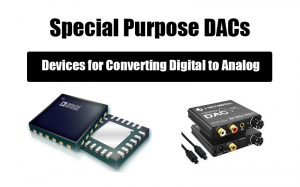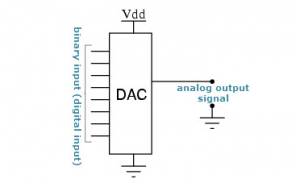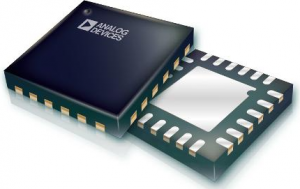Special Purpose DACs: Devices for Converting Digital to Analog

A digital-to-analog converter, also known as a D/A converter or DAC for short, is a device that converts digital quantities into analog.
This article describes the characteristics, conversion methods, and applications of digital-to-analog converters (DACs).
SHENZHEN, GUANGDONG, CHINA, February 16, 2023 /EINPresswire.com/ -- With the rapid development and popularity of digital technology, especially computer technology, in modern control, communication, and detection fields, in order to improve the performance index of the system, the processing of signals is widely used in digital computer technology. As the actual object of the system is often some analog quantities (such as temperature, pressure, displacement, image, etc.), in order to make the computer or digital instrument can recognize and process these signals, must first convert these analog signals into digital signals; and the digital quantities output by the computer after analysis and processing often need to be converted to the corresponding analog signals in order to be accepted by the actuator. In this way, a digital-to-analog converter is needed to bridge the gap between analog and digital signals.
A digital-to-analog converter, also known as a D/A converter, or DAC for short, is a device that converts digital quantities into analog. a D/A converter consists of four parts: a power resistor network, an operational amplifier, a reference power supply, and an analog switch. a DAC can precisely reconstruct the sampled data into an analog signal. Digital data can be generated by microprocessors, application-specific integrated circuits (ASICs) or field-programmable gate] arrays (FPGAs), but the final data needs to be converted to analog signals in order to interact with the real world.
Features of Special Purpose DACs
DAC mainly consists of a digital register, an analog electronic switch, a bit power network, a summing operational amplifier, and a reference voltage source (or a constant current source). Each digit of the digital quantity stored in the digital register controls the analog electronic switch of the corresponding bit so that the digit of 1 generates a current value proportional to its bit power on the bit power network, and then the operational amplifier sums up the current values and converts them into voltage values.
Depending on the bit power network, different types of DACs can be formed, such as power-resistance network DAC, R-2R inverted T-resistance network DAC and single-value current network DAC. The conversion accuracy of the power-resistance network DAC depends on the reference voltage VREF, and the accuracy of the analog electronic switch, the operational amplifier, and the value of each power resistor. Its disadvantage is that the resistance value of each power resistor is different, and when the number of bits is large, the resistance value is very different, which makes it very difficult to ensure accuracy, especially for the production of integrated circuits is very unfavorable, so the circuit is rarely used separately in special purpose DACs.
It consists of several identical R, 2R network sections, each section corresponds to an input bit. The R-2R inverted T-shaped resistor network DAC is one of the faster and more applied ones. Compared with the power resistor network, it has only two resistance values, R and 2R, thus overcoming the disadvantages of the power resistor with many resistance values and large differences in resistance values.
Current type DAC is a constant current source switched to the resistor network, the constant current source internal resistance is extremely large, equivalent to an open circuit, so together with the electronic switch, the impact on its conversion accuracy is relatively small, and because the electronic switch mostly uses non-saturated ECL switching circuit, so that this DAC can achieve high-speed conversion, conversion accuracy is higher.
Conversion Methods of Special Purpose DACs
Digital quantities are represented by codes combined by digits, and for the entitled codes, each code has a certain bit power. In order to convert the digital quantity into analog quantity, each 1-bit code must be converted into the corresponding analog quantity according to the size of its bit power, and then these analog quantities can be added together to obtain the total analog quantity proportional to the digital quantity, thus realizing the digital-to-analog conversion. This is the basic guideline to compose a D/A converter.
The D/A converter consists of digital registers, analog electronic switching circuit, decoding network, summation circuit and reference voltage. The digital quantity is input and stored in the digital register in serial or parallel mode, which then outputs each digit to control the analog electronic switch of the corresponding bit, resulting in the digit 1 bit creating a current based on its power value on the bit power network, and then adding up the various power values to get the analog quantity corresponding to the digital quantity using the summation circuit.
Applications of Special Purpose DACs
DAC digital-to-analog converters are used in many digital signal processing applications and more, some of which are briefly listed below:
1. Audio amplifier
In microcontrollers, the DAC is used to generate DC voltage gain. Usually, DAC will be integrated into the whole audio codec including the signal processing function.
2. Video encoder
The video encoder system will process the video signal and send the digital signal to various DACs to generate analog video signals in various formats while optimizing the output level. As with audio codecs encoders, these ICs may have integrated DACs.
3. Electronic display
Graphics controllers typically use lookup tables to generate data signals sent to video DACs for analog outputs, such as red, green, and blue (RGB) signals to drive displays. The model AD7147PACPZ-500R7 can be used for personal music and multimedia players and more.
4. Data acquisition system
Analog-to-digital converters (ADCs) digitize the data to be measured and send it to the processor. In addition to the data acquisition console, the processor will send feedback data to the DAC for conversion.
5. Calibration
In order to ensure the accuracy of the test and measurement system, the DAC provides dynamic calibration for gain and voltage offset.
6. Motor Control
Many motor controls require voltage control signals, and DACs are well suited for such applications that may be driven by processors or controllers.
7. Data Distribution System
Many industrial and factory production lines require multiple programmable voltage sources, which a set of multiplexed DACs can generate. DACs allow the voltage to be dynamically changed during system operation.
8. Digital Potentiometers
String DAC architecture is used in almost all digital potentiometers.With some reorganization of the resistor/switch array and the addition of an I2C-compatible interface, an all-digital potentiometer can be implemented.
9. Software Radio
DACs are used in conjunction with digital signal processors (DSPs) to convert signals to analog for transmission in mixer circuits and then to the radio's power amplifier and transmitter.
Conclusion
These are the characteristics, conversion methods, and applications of digital-to-analog converters (DACs), and I hope you have a better understanding of their concepts. Digital-to-analog converters (DACs) are very common in electronic circuits and are also very widely used. It should be noted that when using a DAC, it is necessary to take into account the power supply rejection ratio, the operating temperature range, the error of misalignment, gain error, nonlinearity error, and other relevant parameter criteria.
Click Here to get more details about Special Purpose DACs
Gloria
Utmel Electronic Limited
info@utmel.com
Legal Disclaimer:
EIN Presswire provides this news content "as is" without warranty of any kind. We do not accept any responsibility or liability for the accuracy, content, images, videos, licenses, completeness, legality, or reliability of the information contained in this article. If you have any complaints or copyright issues related to this article, kindly contact the author above.


